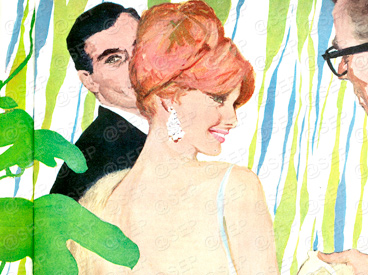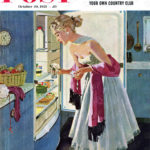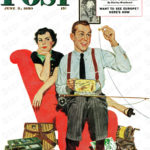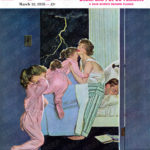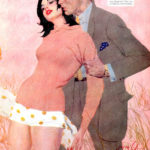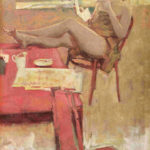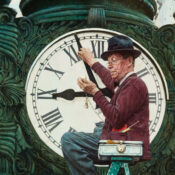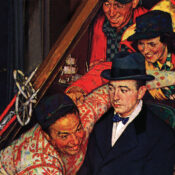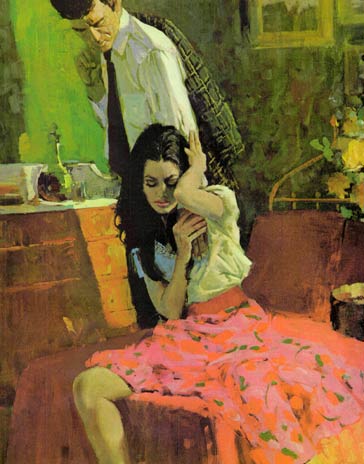
Popular spy novelist and Post contributor John le Carré’s short story, “What Ritual is Being Observed Tonight?” (November 2, 1968) recently caught the attention of our online readers.
But it wasn’t the text or its famous author that Post fans were raving about. Instead, it was what one reader dubbed “the gorgeous illustration” (right), which accompanied le Carré’s romantic tale.
The artist who stole le Carré’s limelight is Maxwell Coburn (Coby) Whitmore, who illustrated more than 100 short stories–including le Carré’s–and eight classic Post covers.
Whitmore’s sultry illustrations were usually viewed by the editors as too risqué for the cover. Yet the fashionable teenage girl in Prom Memento (below) was judged wholesome enough for public display.
The use of light in this composition draws one’s attention to a keepsake from a special evening.
Notice the attention to detail: the mundane items in the refrigerator, the dance card and gloves tossed onto a counter, and a clock reading close to 1:30 a.m. The white of the dress and refrigerator door get a punch of color from a fringed fuchsia shawl.
Whitmore knew that he wanted to be an artist before he graduated high school. After attending the Dayton Art Institute he moved to Chicago where he worked with Post illustrators Ben Stahl and Thornton Utz.
In the early 1940s, Whitmore moved to New York, where he spent the bulk of his career. He worked with Jon Whitcomb at the well-respected Cooper studio. And throughout the 1940s and 1950s, according to artist blogger Leif Peng, hardly an issue of Ladies Home Journal and Good Housekeeping went by without story and/or advertising art by Whitmore and Whitcomb.
While the wife in Fishing Season (below) bemoans a husband who finds lures more alluring than she, Post editors were pleased to note that Whitmore’s own spouse was not a fishing widow.
“The only time her artist husband ever went fishing, he dragged a vast pike into his boat, and the pike got sore and made terrifying passes at him. Whitmore slew the beast finally with his shoe, and turned to another hobby—extra fast automobiles.” At the time of this cover, the Whitmores owned a “super-sports model Jaguar” and were “getting their fun out of knowing they could zoom the hooded cyclone up 130 mph if they dared.”
1950 was also the year Whitmore helped design a unique and highly successful racecar, the Fitch-Whitmore Le Mans Special.
“These were Coby Whitmore’s women and they were the ideal for 30 years,” said the Society of Illustrators as Whitmore was inducted into their Hall of Fame in 1978. “They were sunny blondes, curled up on couches, or creamy brunettes gazing over champagne glasses.”
They were also stunning redheads with Audrey Hepburn hairdos, like the illustration from the 1960 Post short story, “Money on Her Mind” by Willard Temple. The Hepburn-inspired coif was no accident. According to illustration expert Walt Reed in Great American Illustrators, Whitmore had to have “a thorough knowledge of fashion trends. Since the pictures oftentimes were not published until several months after being painted, styles chosen had to be advanced enough to avoid looking dated when they appeared.”
“He stopped talking and put his arms around her. There was no resistance worth recording.” This provocative caption appeared below the Whitmore illustration above. The caption, pulled from the Post story “The Lady and the Landlord,” is what Reed defines as “the clinch,” or the logical highlight in a romantic storyline. Variations on a romantic embrace would seem to be limited, Reed notes, but “Whitmore always came up with something new.” The industrious illustrator also created romantic scenes for McCall’s, Ladies’ Home Journal, Redbook, Cosmopolitan, among others.
“Racing cars, illustrating, and smart clothes on good-looking women,” Whitmore said these were his three primary interests. While Whitmore the racer was simply indulging in a hobby, Whitmore the artist was a fastidious professional who, writes Reed, was “so inventive over so long a time in doing variations on the theme of ‘boy meets girl.’” Though in this 1958 illustration, he depicted what happens after boy meets girl.
More than just another provocative pose, this often-overlooked Whitmore illustration (above) is an elegant study in pastels. The accompanying story, “The Visitor” by Audrey A. Boughton, was not a typical romance, but a story of a widow who receives a letter from a past love.
The beauty of Coby Whitmore went well beyond his skill with a paintbrush; according to the Society of Illustrators, he was “a dashing fellow” with a penchant for white suits and “a child’s delight in all things. A man of genuine humility, he seems truly not to know how good he is. Bob Levering [Whitmore’s co-worker and a fellow Post artist], characterized him as having a ‘great, ambling confused amiability. And underneath he’s sharp as a razor blade.’”
Become a Saturday Evening Post member and enjoy unlimited access. Subscribe now
